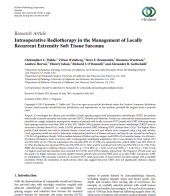OVERVIEW
To investigate the efficacy and morbidity of limb-sparing surgery with intraoperative radiotherapy (IORT) for patients with locally recurrent extremity soft tissue sarcoma (ESTS).
METHODS AND MATERIALS
Twenty-six consecutively treated patients were identified in a single institution retrospective analysis of patients with locally recurrent ESTS treated with IORT following salvage limb-sparing resection from May 2000 to July 2011. Fifteen (58%) patients received external beam radiotherapy (EBRT) prior to recurrence (median dose 63 Gy), while 11 (42%) patients received EBRT following IORT (median dose 52 Gy). The Kaplan-Meier product limit method was used to estimate disease control and survival and subsets were compared using a log rank statistic, Cox’s regression model was used to determine independent predictors of disease outcome, and toxicity was reported according to CTCAE v4.0 guidelines.
RESULTS
With a median duration of follow-up from surgery and IORT of 34.9 months (range: 4 to 139 mos.), 10 patients developed a local recurrence with 4 subsequently undergoing amputation. The 5-year estimate for local control (LC) was 58% (95% CI: 36–75%), for amputation-free was 81% (95% CI: 57–93%), for metastasis-free control (MFC) was 56% (95% CI: 31–75%), for disease-free survival (DFS) was 35% (95% CI: 17–54%), and for overall survival (OS) was 50% (95% CI: 24–71%). Prior EBRT did not appear to influence disease control (LC, p= 0.74; MFC, p = 0.66)or survival(DFS, p= 0.16; OS, p = 0.58). Grade 3 or higher acute and late toxicities were reported for 6 (23%) and 8 (31%) patients, respectively. The frequency of both acute and late grade 3 or higher toxicities occurred equally between patients who received EBRT prior to or after IORT.
CONCLUSION
In conclusion, this study demonstrates that incorporation of IORT as a component of multimodality management of patients with locally recurrent ESTS achieves high rates of local control and limb salvage with acceptable treatment morbidity and suggests that prior EBRT does not significantly influence disease control or toxicity. This technique offers a method of delivering focal therapy to achieve local control for the majority of patients who otherwise may require more radical surgical procedures.
